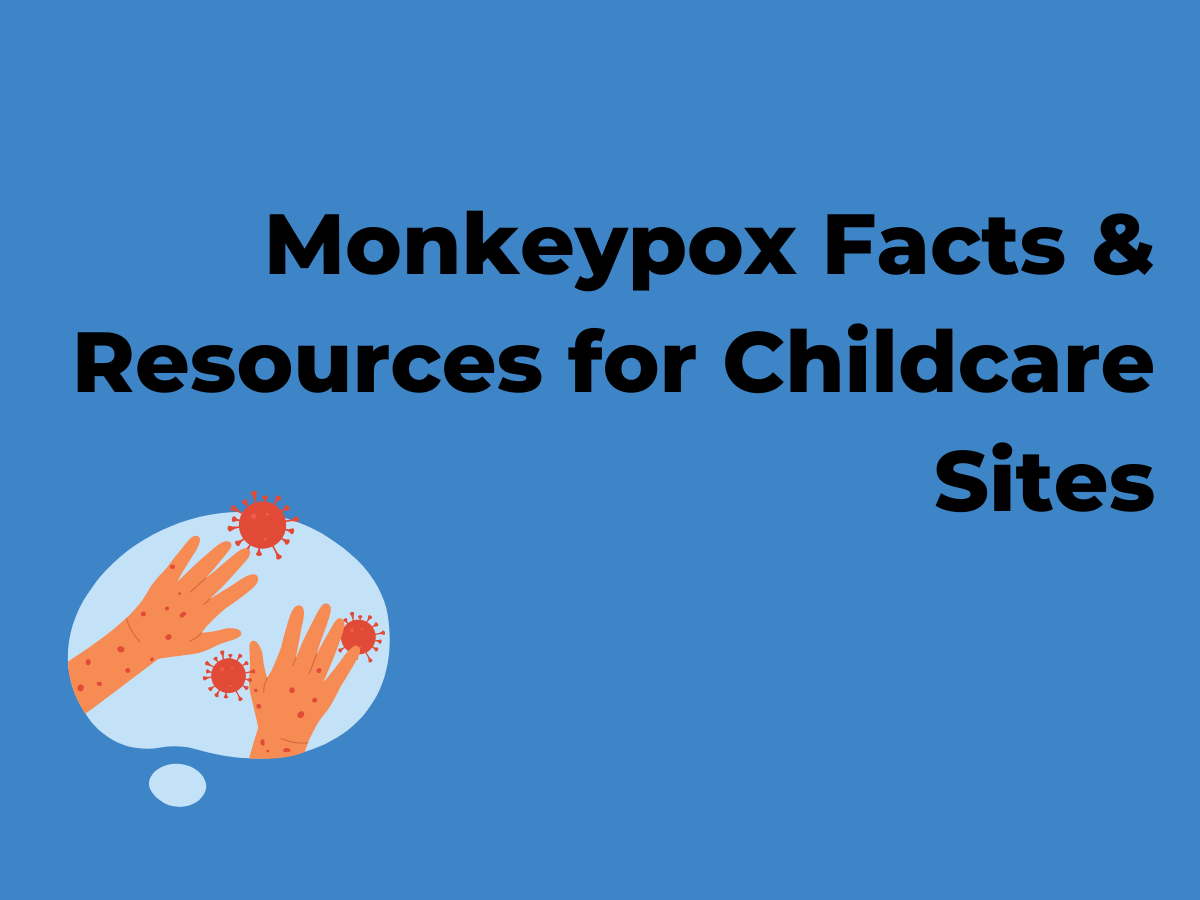Facts and Resources for Monkeypox at CACFP Childcare Sites
September 7, 2022

On August 4th, the Department of Health and Human Services determined that the ongoing spread of the monkeypox virus is a public health emergency. While children are thankfully at a low risk for monkeypox, meeting the moment still demands staying up to date on best practices for health and safety when it comes to the monkeypox outbreak.
First things first: Monkeypox is a virus with symptoms including a painful rash that goes through several stages, including blisters and scabs. It can also have flu-like symptoms, such as fever, chills, headache, and even respiratory symptoms. Symptoms usually begin within three weeks of exposure and last for two to four weeks. Monkeypox is most commonly spread through close personal contact. Unfortunately, this has led to the misconception that monkeypox is a sexually transmitted infection (STI) when, in fact, it can be spread through any skin-to-skin contact, intimate or not.
Below are FAQs and resources for managing monkeypox specifically at childcare sites. For information on monkeypox in congregate settings, such as emergency shelters and senior homes, visit this CDC summary page.
Monkeypox and Childcare FAQs
The following Frequently Asked Questions come from the CDC’s monkeypox guidance. Visit the CDC’s Monkeypox > Community Settings page for a complete list of FAQs.
- Should a parent, teacher or student with a rash get tested for monkeypox?
Currently, the risk of monkeypox to children and adolescents is low. Several illnesses can cause a rash and fever in children, such as hand-foot-mouth disease and chickenpox (varicella). For a child without a known exposure to monkeypox, a fever and rash should be evaluated by a medical professional and settings should follow their standard illness policies for these situations. A healthcare provider can determine what treatment or testing the child needs. It is important to avoid stigma and fear-based exclusion of children and adolescents. If a child has a known exposure to monkeypox (i.e., is being monitored for monkeypox) and develops symptoms, follow information found in “What should we do if a person who has been exposed to monkeypox develops symptoms while in our setting?”
There are also multiple potential causes of rashes in adults. Parents, teachers, and staff members should understand the symptoms of monkeypox and see a healthcare provider if they remain concerned. Adults with symptoms of monkeypox should also:
- Avoid close contact, including sex or being intimate with anyone, until they have been checked out by a healthcare provider.
- Visit a public health clinic near them if they don’t have a provider or health insurance.
- Wear a well-fitting mask when they see a healthcare provider and remind them that this virus is circulating in the area.
- What do we do if there is a case of monkeypox in our setting?
If someone with monkeypox has been in a school, ECE, or other setting serving children or adolescents, the setting should follow their everyday operational guidance to reduce the transmission of infectious diseases and add enhanced cleaning and disinfection.
- Clean the classroom/space: The areas where the person with monkeypox spent time should be cleaned and disinfected before further use. Focus on disinfecting items and surfaces that were in direct contact with the skin of the person with monkeypox, or often in the presence of the person with monkeypox. If unsure, disinfect. Follow the guidance for Disinfecting the Home and Other Non-Healthcare Settings to clean and disinfect surfaces, floors, and shared items such as toys, learning materials, sports equipment, or uniforms used by the person with monkeypox. Caring for our Children 4.9.0.11 and Caring for Our Children 3.3.0.2 provide information on how to clean and sanitize items that may go into the mouth, like utensils and certain toys. Linens or towels that the person with monkeypox used should be laundered. Items that cannot be cleaned, disinfected, or laundered should be thrown away. Children, staff (other than those who are cleaning and disinfecting), and volunteers should not enter the area until cleaning and disinfection is completed. General guidance on cleaning, sanitizing, and disinfecting can be found in Caring for Our Children.
- Support the health department in contact tracing: Contact tracing can help identify people with exposure to someone with monkeypox and may prevent additional cases. Settings serving children and adolescents should contact their health department if a person with confirmed monkeypox has been in their facility and should support efforts to identify individuals who might have been exposed to the virus.
- Communicate:Provide information about preventing the spread of monkeypox to staff members, volunteers, students (when age appropriate), and parents. Keep messages fact-based to avoid introducing stigma.
- Should settings serving children or adolescents worry about monkeypox?
At this time, the risk of monkeypox to children and adolescents in the United States is low. Monkeypox virus can infect anyone – including children – if they have close, personal, often skin-to-skin contact with someone who has monkeypox. In this outbreak, most cases of monkeypox have been associated with sexual contact. Although less common in the current outbreak, monkeypox may also spread by touching contaminated objects (such as toys or eating utensils), fabrics (clothing, bedding, sleeping mats, or towels), and surfaces that have been used by someone with monkeypox.
Additional resources and information
Reducing Stigma in Monkeypox Communication and Community Engagement
